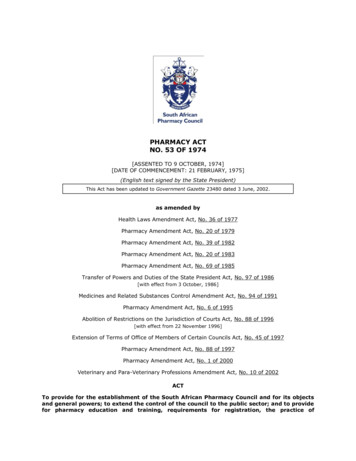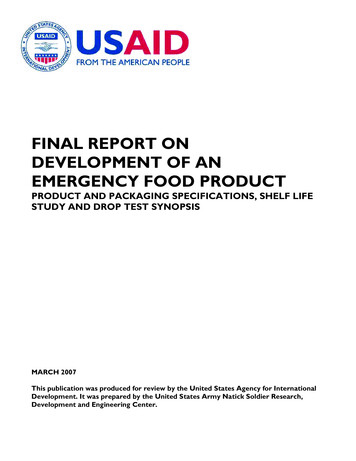
Transcription
STRATEGIC FRAMEWORKACT Government Health DirectorateFood and Nutrition Strategic Framework2012-2018
Photo credits:Page 16 - Warm Roasted Vegetable Salad image from Healthy Food Fast State of WesternAustralia 2012, reproduced with permission.1Food and nutrition strategic framework: 2012 - 2018
ContentsForewordKey messagesAbbreviations1.Introduction . 82.Strategic goal and aims . 83.Scope and purpose . 94.Guiding principles . 95.Governance. 106.Policy context . 106.1.National policy context . 106.2.ACT policy context . 106.3.Links with other strategic documents . 117.Diet and the burden of disease . 118.Healthy eating – the economic imperative . 139.Australian Dietary Guidelines and recommendations . 1310. Food and nutrition issues in the ACT . 1410.1.Reducing rates of overweight and obesity . 1410.2.Improving adherence to Australian Dietary Guidelines . 1510.3.Increasing vegetable and fruit consumption . 1510.4.Increasing breastfeeding rates and duration . 1610.5.Reducing salt consumption . 1710.6.Improving nutrition in the elderly . 1810.7.Reducing specific micronutrient deficiencies. 1810.8.Improving food and nutrition security . 1910.9.Advocating for a sustainable and healthy food supply . 1910.10. Protecting food safety . 202Food and nutrition strategic framework: 2012 - 2018
11. Factors that influence food and dietary intakes . 2112. Strategic areas for action . 2212.1.Support individuals to adopt healthy eating behaviours. . 2312.2.Foster environments that support healthy eating. . 2512.3.Promote safe, nutritious and sustainable food supply. . 2612.4.Build the evidence for intervention. . 2712.5.Build capacity . 28Appendix A: Guiding principles . 29Appendix B: Associated strategic documents . 30Appendix C: Burden of disease . . 32Appendix D: Australian Dietary Guidelines . 36Appendix E: Consumption of energy dense foods and drinks . 37Appendix F: Benefits of breastfeeding . 38Appendix G: Undernutrition in the elderly. 39Appendix H: Micronutrient deficiencies . 43Appendix I: Food insecurity. 48Appendix J: Factors impacting on the sustainability of Australia’s food supply . 50Appendix K: Examples of factors that influence food and dietary choices . 52References . 553Food and nutrition strategic framework: 2012 - 2018
ForewordIt gives me great pleasure to endorse the ACT Government HealthDirectorate Food and Nutrition Strategic Framework 2012- 2018.Although Canberrans enjoy comparatively good health, theprevalence of chronic disease is increasing and our ageing populationplaces ever-increasing pressures on the finite resources of our healthsystem.Promoting and supporting healthy eating and the availability ofhealthy food within the population can play a vital role in relievingthese pressures. Good nutrition can help protect against ill health aswell as helping to improving the quality of life of those with a chronicdisease. Poor nutrition, on the other hand, plays a direct role in thedevelopment and progression of chronic health conditions.This Framework seeks to highlight good nutrition as a priority for theHealth Directorate and create greater recognition of the importance of healthy eating inoptimising health outcomes. It brings together current evidence and identifies key food andnutrition issues for the ACT population. It also sets out our key strategic priorities.Many factors which can make a positive contribution to the availability of healthy food andhealthy eating are outside of the direct control of the Health Directorate, including: the sale andpromotion of healthier food by food outlets; improving access by vulnerable populations to freshhealthy food; socioeconomic factors such as income support and education; encouraging localfood production and provision of incentives to promote consumption of fresh fruit and vegetables.The Framework therefore describes the role of the Health Directorate in advocating with othersectors for the role they can play in promoting good nutrition.The recent Healthy Weight ACT budget initiative will build on the foundation work captured in thisFramework to inform the development of the ACT Healthy Weight Action Plan.The Health Directorate for its own part will continue to work towards, and advocate for,innovative ways to promote healthy food and healthy eating in our daily work and play, and in ourschools, families and communities, so that the healthy food and drink choices can be the easychoice.Katy GallagherMinister for Health7 September 20124Food and nutrition strategic framework: 2012 - 2018
Key Messages Optimal nutrition is necessary for healthy growth and development and maintaining goodphysical and mental health throughout the whole of life.Poor nutrition plays a direct role in the development and progression of chronic conditionsthat account for a high proportion of deaths, disability and illness in the ACT, such ascardiovascular disease, overweight and obesity, type 2 diabetes and some forms of cancer.Most diet-related disease is associated with:- excessive intake of foods and drinks (including alcohol) that are high in energy(kilojoules), saturated fat, added or refined sugars or salt; and/or- inadequate intake of nutrient-dense foods, including vegetables, fruit and wholegraincereals.In 2009-10 over half of ACT adults and almost 20% of children were either overweight orobese. Over 16% of the population had high blood pressure and over 12% had high bloodcholesterol. In addition, over 90% of the adult population did not eat sufficient vegetables tosupport good health.There are significant economic costs associated with diet-related disease including directhealth care system costs associated with managing diet-related conditions, and the indirectand intangible costs to individuals and society from pain and suffering, income loss and lostproductivity. There is therefore an important economic imperative for the Health Directorateto work to improve dietary intakes and nutrition.The Health Directorate’s food and nutrition strategic goal is to improve the health andwellbeing of the ACT population and reduce rates of diet-related chronic disease throughpromoting and supporting optimal nutrition. It aims to:- increase the proportion of the population who consume a diet consistent with AustralianDietary Guidelines (including breastfeeding); and- improve access by the population to a safe, nutritious, affordable and sustainable foodsupply.Key food and nutrition issues facing the ACT include:- Reducing rates of overweight and obesity- Improving adherence to Australian Dietary Guidelines- Increasing vegetable and fruit consumption- Increasing breastfeeding rates and duration- Reducing salt consumption- Improving nutrition in the elderly- Reducing specific micronutrients deficiencies- Improving food and nutrition security- Advocating for a sustainable and healthy food supply- Protecting food safetyDietary behaviours are influenced by the interrelationship of personal factors (which shapemotivation and abilities), social factors and environmental factors, supported by theavailability of research, information and workforce capacity. Healthy behaviours occur whenindividuals have the necessary motivation and abilities plus opportunities provided by theirenvironment.Disadvantaged groups tend to have fewer personal and economic resources to help themovercome negative environmental factors, therefore creating supportive environments is5Food and nutrition strategic framework: 2012 - 2018
essential to making healthy food choices the easy choices for individuals in this group inparticular.The factors that influence the food supply and nutrition behaviours need to be addressedwhen developing strategies to improve dietary intakes. The Health Directorate can influence anumber of these factors either directly (through Health Directorate policies, strategies,programs and services) or indirectly through advocacy and collaboration with other agenciesand sectors.Priority strategic areas for action by the Health Directorate are:- Support individuals to adopt healthy eating behaviours- Foster environments that support healthy eating- Promote a safe, healthy and sustainable food supply- Build the evidence for intervention- Develop capacity of the workforce6Food and nutrition strategic framework: 2012 - 2018
ROCVDFAOHealth SRIThe FrameworkUSAWCRFWHOAustralian Bureau of StatisticsAustralian Chronic Disease Prevention AllianceAustralian Capital TerritoryAustralian Dietary GuidelinesAustralian Food and Grocery CouncilAustralian Guide to Healthy EatingAmerican Institute for Cancer ResearchAustralian National Preventive Health AgencyBurden of Disease and InjuryCommonwealth Scientific and Industrial Research OrganisationCardiovascular DiseaseFood and Agriculture Organization of the United NationsACT Government Health DirectorateHealth Improvement Branch, Population Health DivisionHealth Protection Service, Population Health DivisionMaternal and Child HealthNational Health and Medical Research CouncilNational Obesity TaskforceNational Partnership Agreement on Preventive HealthNational Preventative Health TaskforceOffice of the Chief Health OfficerPopulation Health Division, Health DirectorateProtein-Energy UndernutritionQuick-Service Restaurant IndustryACT Government Health Directorate Food and Nutrition StrategicFrameworkUnited States of AmericaWorld Cancer Research FundWorld Health Organization7Food and nutrition strategic framework: 2012 - 2018
1. IntroductionThere is a close relationship between nutrition and health. Optimal nutrition1 is necessary forhealthy growth and development in infants, children and adolescents. Consumption of a variedand nutritious diet is essential for maintaining good physical and mental health throughout thewhole of life (WHO 2003). In addition, sharing and enjoying food in a social setting can contributeto social connectedness, mental health and wellbeing.On average, the population of the ACT enjoys relatively good health. However chronic diseasessuch as cardiovascular disease (CVD), type 2 diabetes and cancer are of significant concern andaccount for a high proportion of deaths, disability and illness in the ACT (ACT Health 2010a). TheWorld Health Organization (WHO) has identified that healthy eating plays a key role in theprevention and management of a number of chronic lifestyle-related diseases (WHO 2003).Amongst the Australian population, most of the burden of chronic disease associated with poornutrition is due to: excessive intake of foods and drinks (including alcohol) that are high in energy (kilojoules),saturated fat, added or refined sugars or salt; and/or inadequate intake of nutrient-dense foods, including vegetables, fruit and wholegraincereals (NHMRC 2011a).2. Strategic goal and aimsThe ACT Government Health Directorate (Health Directorate) works towards a vision of goodhealth and wellbeing for the population of the ACT. Improving the nutrition of the ACT populationis an important element of this vision.The Health Directorate’s food and nutrition strategic goal is: to improve health and wellbeing and reduce rates of diet-related chronic disease throughpromoting and supporting optimal nutrition.In working towards this strategic goal, the Health Directorate aims to: increase the proportion of the population who consume a diet consistent with AustralianDietary Guidelines (including breastfeeding); and increase access by the population to a safe, nutritious, affordable and sustainable foodsupply.The Health Directorate works in the areas of food and nutrition in a variety of ways across thecontinuum of care, from health promotion and disease prevention through to provision of healthservices to assist individuals to manage health conditions through diet. The types of food andnutrition interventions undertaken by the Health Directorate include: population-based health promotion and disease prevention programs legislation, regulation and enforcement health services targeting individuals and groups (including nutrition and dietetics)1Nutrition that meets an individual’s needs for a healthy active life8Food and nutrition strategic framework: 2012 - 2018
communication and social marketingeducation and skill developmentfood and nutrition policiesfood servicescapacity building within the health workforceleadership in workplace health and wellbeinghealth, nutrition and food safety surveillance, monitoring and reportingresearch and evaluation, including quality improvement activities.3. Scope and purposeThis ACT Government Health Directorate Food and Nutrition Strategic Framework: 2012-2018 (theFramework) has been developed to assist Health Directorate staff to understand the key food andnutrition issues facing the population of the ACT and to take action to address these issues. TheFramework therefore identifies: key food and nutrition issues affecting the ACT population strategic areas for action by the Health Directorate guiding principles to underpin the Health Directorate’s roles in food and nutrition.The Framework has a high level strategic focus on issues and areas for action that affect the wholeACT population and vulnerable subgroups of the population. It focuses on promoting healthyeating in accordance with Australian Dietary Guidelines amongst the general population. TheFramework is not intended to guide clinical practice in the management of individuals’ healthconditions where specific dietary advice and intervention is required.The Framework will also be used to inform stakeholders and the community about the HealthDirectorate’s roles in food and nutrition.4. Guiding principlesIn implementing this Framework, the Health Directorate will be guided by the following principles:a) Implementing evidence-based policy and practiceb) Developing whole-of-population approachesc) Developing whole-of-system approachesd) Implementing sustainable approachese) Valuing prevention and health promotionf) Empowering consumersg) Recognising human rightsh) Addressing health inequalitiesi) Leading by exampleA description of these guiding principles can be found at Appendix A.9Food and nutrition strategic framework: 2012 - 2018
5. GovernanceThe Framework has been endorsed by the Health Directorate’s Executive Council. The Executiveresponsible for the oversight of the Framework is the Chief Health Officer. Responsibility formonitoring of the Framework lies with the Population Health Division, however the responsibilityfor implementation and evaluation of individual action areas lies with relevant divisions andbranches within the Health Directorate.The Framework recognises the key roles played by other sectors of government, and by the nongovernment, community and business sectors in producing positive food and nutrition outcomesfor the ACT population. While the Health Directorate has no authority to direct the activities ofthese sectors, its skill in influencing and advocating effectively for positive policy outcomesthrough establishing and maintaining effective and productive partnerships will be a key factor inthe success of the Framework.6. Policy context6.1. National policy contextThe Framework is set in the context of an increased national focus on prevention. In November2008, the Council of Australian Governments agreed to a National Partnership Agreement onPreventive Health (NPAPH), to focus all States and Territories on prevention of chronic disease.The NPAPH aims to ensure Australians are equipped and supported to make healthy lifestylechoices and manage key risk factors relating to chronic disease including poor nutrition. A primaryfocus of the NPAPH is to address the rising prevalence of lifestyle related chronic diseases throughthe implementation of a broad range of initiatives in settings such as communities, early childhoodeducation and care environments, schools and workplaces.As part of the NPAPH, States and Territories are working towards seven agreed outcomes relatedto physical activity, nutrition, healthy weight, and smoking. The nutrition-related outcomes are:1) increase the proportion of children and adults meeting national guidelines for healthyeating by 15 per cent within six years.2) increase the proportion of children and adults at healthy body weight by three percentagepoints within ten years.The Australian National Preventive Health Agency (ANPHA) was established by the AustralianGovernment on 1 January 2011 to strengthen Australia’s investment and infrastructure inpreventive health. ANPHA supports the development and implementation of evidence-basedapproaches to preventive health initiatives targeting obesity, harmful alcohol consumption,tobacco and other substance abuse.6.2. ACT policy contextThe 2009-10 ACT Budget allocated 11 million over three years to support a Healthy Future Preventative Health Program which included a range of initiatives aimed at promoting healthylifestyles and preventing or reducing risk factors for chronic disease. These initiatives were10Food and nutrition strategic framework: 2012 - 2018
focussed on priority areas of action that closely reflect developments in the preventive healthagenda at the national level through the NPAPH.NPAPH Nutrition Outcomes: Key Performance BenchmarksUnder the NPAPH, the four key performance benchmarks relevant to food and nutrition in the ACT are:a) increase in proportion of children at unhealthy weight held at less than five per cent frombaseline for each state by 2015; proportion of children at healthy weight returned to baselinelevel by 2018.b) increase in proportion of adults at unhealthy weight held at less than five per cent from baselinefor each state by 2015; proportion of adults at healthy weight returned to baseline level by 2018.c) increase in mean number of daily serves of fruits and vegetables consumed by children by atleast 0.2 for fruits and 0.5 for vegetables from baseline for each State by 2015; 0.6 for fruits and1.5 for vegetables by 2018.d) increase in mean number of daily serves of fruits and vegetables consumed by adults by at least0.2 for fruits and 0.5 for vegetables from baseline for each state by 2015; 0.6 for fruits and 1.5for vegetables from baseline by 2018.6.3. Links with other strategic documentsThis Framework is designed to be consistent with the goals and underlying principles of a range ofACT and Health Directorate strategic documents which provide a focus to the Health Directorate’scommitment to promoting healthy lifestyles amongst the ACT population. A list of relevantassociated Health Directorate and ACT Government Frameworks, plans and strategies is located atAppendix B.7. Diet and the burden of diseasePoor diet plays a direct role in the development and progression of a number of conditions,including coronary heart disease, stroke, hypertension, obesity, some forms of cancer, type 2diabetes, osteoporosis, dental caries, gall bladder disease, and dementia (NHMRC 2003b; WHO2003). In addition, shortage of food and a lack of dietary variety cause malnutrition and deficiencydiseases (Wilkinson & Marmot 2003). It has been estimated that poor nutrition is implicated inmore than 56% of all deaths in Australia (Crowley et al 1992).Diet-related disease is a major contributor to the total burden of disease and injury2 (BoD) inAustralia, including in the ACT (ACT Health 2010a). The diet-related diseases with the greatest2The key indicator to measure the burden of disease and injury is the disability-adjusted life year (DALY). It describesthe amount of time lost due to both fatal and non-fatal events or the years of life lost due to premature death coupledwith years of ‘healthy’ life lost due to disability.11Food and nutrition strategic framework: 2012 - 2018
burden in the ACT are CVD (especially coronary heart disease and stroke), type 2 diabetes andsome cancers. The BoD associated with diet is a result of both the direct effects of nutritionfactors on disease states and the effects on diet-related conditions such as high blood pressure,high blood cholesterol, overweight and obesity, which in themselves are risk factors for disease.Information about the burden of disease, prevalence and/or incidence and relationship of keydiet-related diseases and risk factors in the ACT is provided at Appendix C.A recent analysis by Jardine et al (2010) identified high bodymass3 followed by smoking as the largest contributing riskfactors to the total BoD in Queensland, with high body massresponsible for 8.5% of the total burden and smokingresponsible for 7.2%. These were followed by physicalinactivity (6.4%), high blood pressure (5.9%) and high bloodcholesterol (5.3%). Low fruit and vegetable intake contributed2.2% of the total BoD (Jardine et al 2010). The analysisindicates that the four diet-related risk factors (high body mass, high blood pressure, high bloodcholesterol, low fruit and vegetable intake) together with physical inactivity were responsible foraround 16% of the total BoD in 2007 (Jardine et al 2010), ie around double the burden due tosmoking. In the UK, poor nutrition has been estimated to be responsible for around 10% of thetotal burden of disease (Rayner & Scarborough 2005) which is consistent with the results of theQueensland study. Table 1 shows the prevalence and percentage of total BoD associated withfour diet-related risk factors in the ACT.Table 1: Snapshot: Prevalence and percentage of total BoD associated with fourdiet-related risk factors in the ACT.Prevalence in 2009-10Percentage of totalBoD in 2003High blood pressure16.1%*7.6%High body mass52.9% of adults over 18 years19.4% of children 5-17 years6%High blood cholesterol12.4%*5%Low fruit & vegetableconsumption90.1% of adults for vegetables42.9% of adults for fruit2%41% of Year 6 children for vegetablesSource: ACT Health 2010a; ACT Government Health Directorate 2011a; ACT Government Health Directorate 2012a;ACT Government Health Directorate 2012b.* This prevalence was based on the proportion of adults that reported ever being told that they had high bloodpressure or high cholesterol that reported still having the condition at the time of the ACT General Health Survey.3High body mass is defined as body mass index 2512Food and nutrition strategic framework: 2012 - 2018
8. Healthy eating – the economic imperativeHealth expenditure in Australia is projected to grow from 4.0 % of Gross Domestic product (GDP)in 2009-10 to 7.1 % of GDP in 2049-50 (Commonwealth of Australia 2010). Chronic diseases placesignificant strain on Australia’s health care system. There are significant economic costsassociated with diet-related chronic disease, including direct costs to the health care systemassociated with managing diet-related conditions and the indirect and intangible costs toindividuals and society from pain and suffering, income loss and lost productivity. In 2007-08, CVDaccounted for 11 per cent ( 5.9 billion) of total Australian health expenditure and canceraccounted for 7 per cent ( 3.8 billion) (AIHW 2009b).However, not all CVD and cancer are diet-related. It has been estimated that the healthcare costof CVD associated with low consumption of fruit and vegetables is around 235 million per yearand that increasing vegetable or fruit intake in Australia by one serve a day would save 157million per year from the costs of CVD alone (Miller 2002).In 2008, Access Economics (2008) estimated the financial cost of obesity for Australia at 8.3billion and when the net cost of lost wellbeing was added, the total cost of obesity was estimatedat 58.2 billion. They calculated that obesity (BMI 30) in Australia causes: 23.8% of type 2 diabetes; 21.3% of CVD; 24.5% of osteoarthritis; and 20.5% of colorectal, breast, uterine and kidney cancer.Based on population share, the estimated cost of obesity in the ACT was 133 million in financialcosts and a total of 936 million including the cost of lost wellbeing.The economic burden of diet-related disease in the ACT is expected to increase over the nextdecade due to the ageing population and increases in life expectancy, which will result in a heavierdemand for health services (ACT Health 2010a). The potential economic benefit of effectivenutrition-based preventive strategies is therefore substantial.9. Australian Dietary Guidelines and recommendationsThe Australian Dietary Guidelines (ADG) provide population basedrecommendations aimed at promoting health and reducing the burdenof preventable diet-related disease. They are developed by theNational Health and Medical Research Council (NHMRC) and are basedon the best available scientific evidence. The ADG include InfantFeeding Guidelines for Health Workers and a food selection guide, theAustralian Guide to Healthy Eating (AGHE). The AGHE providesinformation about the amounts and types of food that need to beeaten each day to get enough of the nutrients essential for goodhealth and wellbeing, thereby helping Australians to develop the skillsand knowledge necessary to choose a healthy diet.The NHMRC is revising the current ADG and AGHE. Revised Guidelines are expected to be13Food and nutrition strategic framework: 2012 - 2018
available late in 2012. The current ADG are set out at Appendix D. The full documentation forthe current ADG can be found at 9-n30n31-n32-n33-n34. The revised ADG will be available when released athttp://www.eatforhealth.gov.au/.The NHMRC’s Nutrient Reference Values for Australia and New Zealand Including theRecommended Dietary Intakes (2006) outlines the intake levels of essential nutrients consideredadequate to meet the nutritional needs of healthy people for prevention of nutrient deficiencies.The document is intended for use by health professionals to assess the likelihood of inadequateintake in individuals or groups of people. The Nutrient Reference Values can be located athttp://www.nrv.gov.au/.10. Food and nutrition issues in the ACTThis section presents key food and nutrition issues that affect a significant proportion of the ACTpopulation. It is not intended to represent all issues relating to food and nutrition experienced byindividuals in the ACT. These key issues have been identified on the basis of ACT data where theyare available and Australia-wide data where no ACT specific data exists. This section provides abasis for identifying strategic areas for action at a population level by the Health Directorate.10.1. Reducing rates of overweight and obesityOverweight and obesity are associated with increased risk of type 2 diabetes, cardiovasculardisease, some cancers, hypertension, musculoskeletal conditions, respiratory conditions, socialisolation, depression and other psychological disorders, sleep apnoea, cholecystitis (inflammationof the gallbladder), insulin resistance and metabolic syndrome (a combination of conditions thatincrease the risk of cardiovascular disease), hernia, reproductive disorders, urinary incontinenceand skin conditions (NHMRC 2011a).
Framework to inform the development of the ACT Healthy Weight Action Plan. The Health Directorate for its own part will continue to work towards, and advocate for, . Most diet-related disease is associated with: - excessive intake of foods and drinks (including alcohol) that are high in energy . ABS Australian Bureau of Statistics ACDPA .



![Immigration Act [No. 13 of 2002] - Gov](/img/30/a13-020.jpg)






